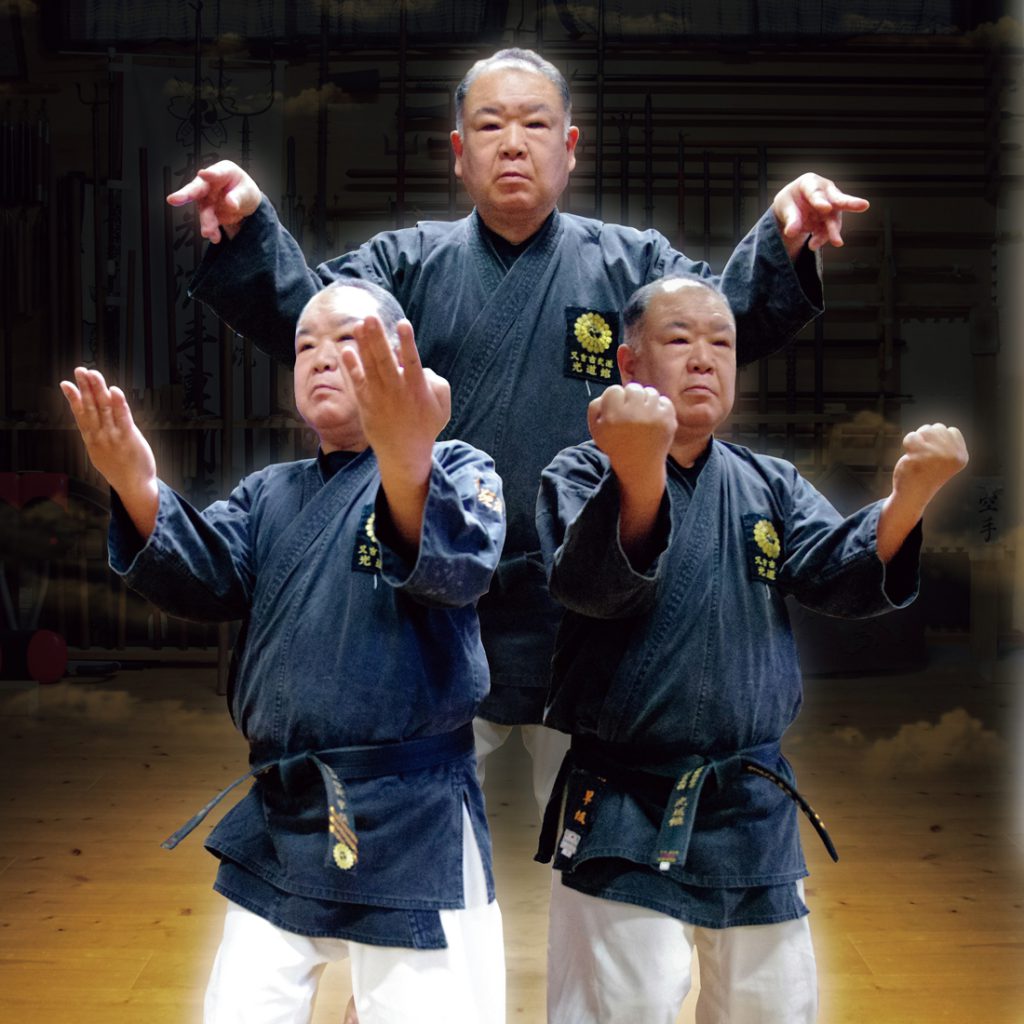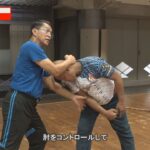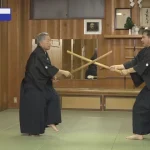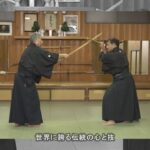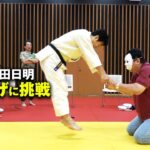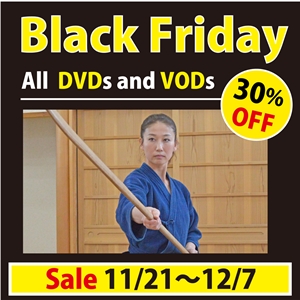The Ryûkyû’s warriors training from Matayoshi Tradition : Three sanchin
Kingairyû Hayasaka Yoshifumi (金硬流唐手・早坂義文)
text by Satoshi Taito, translation by Lionel Lebigot
Hayasaka Yoshifumi –
Born on February 27, 1958 in Miyagi Prefecture
In 1970, he undertook the study of the jûdô of which he is currently 5th dan.
In 1972, he began studying Senbukan Gôjû-ryû karate.
In 1974, he continued the study of Gôjû-ryû at Dôjô Gôbukan
In 1976, he was introduced to the Kenso-ryû Jû-Jutsu, of which he was a menkyo-kaiden.
In 1978, under the direction of Matayoshi Shinpô, he began the practice of Okinawa kobujutsu, Kingai-ryû, Kyan Shôrin-ryû, Okinawa Gôjû-ryû and Shôrin-ha Tsuruken.
He received the title of Kyôshi in Gôjû-ryû from Kina Masaoki, one of Miyagi Chôjun’s first students and also a pupil of Motobu Chôyû of Motobu-ryû.
In 1981, he graduated from the Faculty of Social Welfare at Tohoku Fukushi University, and joined the Metropolitan Police Department.
In 1997, he received the “menkyo-kaiden/complete education diploma” in Kingai-ryû, from Matayoshi Shinpô. After working as a police inspector in the 1st Investigation Division and the Forensic Division, he retired after attaining the rank of chief of the Hachijojima police station.
In 2013, he inherited the title of sôke
– the seventh generation of the Shuriken-jutsu of the Negishi-ryû,
– the fourteenth generation of Shirai-ryû,
– and the sixteenth generation of Yamamoto-ryû Iaijutsu.
Hayasaka shihan inherited martial arts studied by Akira Saito.
Hayasaka shihan is a regular member of the Nippon Kobudô Association and a permanent member of the Board of Directors for the promotion of Japanese Kobudô.
For many generations, the Matayoshi family has transmitted and preserved the armed and unarmed combat techniques of the Ryukyu kingdom.
Matayoshi Shinpô taught Hayasaka Yoshifumi three sanchins: Naha-sanchin, Shuri-sanchin and Tsuru-sanchin (Crane Boxing’s sanchin)
For the first time on public display, we had the opportunity to see the details of these three sanchins, which convey the essence of Ryukyu’s martial arts: positions, movements and breaths. Each of these three sanchins has a different pattern and purpose.
Sanchin and the Ryûkyû kobujutsu
The Matayoshi family descends from a family of warriors from the Ryûkyû kingdom, initiated by Ufugushiku Shinbu [1] in the 14th century. The family’s skills in weaponry also enabled them to ensure the safety of the ships that made the crossing from Naha to China (and back) on trade missions during the Ming and Qing dynasties.
Matayoshi Shinkô (15th generation) inherited the family tradition of arms from his father Shinchin. To perfect his knowledge and skills, he undertook a journey that took him to Sakhalin, Manchuria, Annam and then Fuzhou. In Okinawa, Shinkô met Wu Xiangui (Japanese name: Yoshikawa Kenki), a tsuruken practitioner of Fujian Shaolin who lived permanently in Okinawa. When he arrived in Fuzhou and on Kenki’s recommendation, his father Wu Jiaogui taught him Fujian Shaolin Ken. Moreover, thanks to Wu’s introduction to the old Kingai-laoshi, he learned Shaolin Kung Fu from the Southern School (Boxing of Arhat (monks), Crane, Tiger, Mantis and Monkey). After a long period of martial arts training on the mainland, Shinkô returned to Naha to trade and teach martial arts.
At his death, the fighting arts in which Shinkô had trained relentlessly were passed on to his son, Shinpô, the 16th heir of the family tradition.
[1]It is from this character that all the male children of the Mâ family (麻) and whatever the branches (Matayoshi, Gima, Sawada…) took Shin (眞 ou真, modern kanji) as the first kanji of their first name.
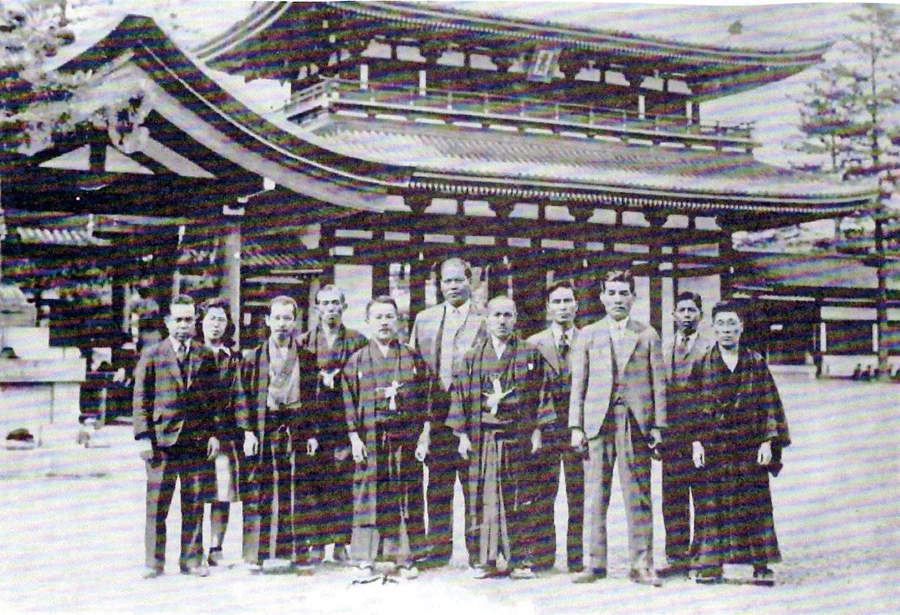
Matayoshi Shinkô (second person on the left, first row),photo taken during the demonstration of the Butokuden of Kyôto in 1939.

Tsuru-no-Te by the students of Wú XiánGuì /Go KenKi
Matayoshi Shinpô, the 16th generation of the Matayoshi family, taught the armed techniques of Ryûkyû, as well as the techniques of hand-to-hand combat which he named kingai-ryû, when the era of “ryû” denominations reached Okinawa.
Among the ancient traditions of Okinawan karate, the kata sanchin is the most important of the Naha-te tradition.
The kata consists of moving forward by repeating uke (parries) and tsuki (strikes) alternately to the left and to the right with powerful breathing. Although the form seems extremely monotonous, it is sometimes described as “standing Zen or Zen on the move” because it involves an awareness of the mind, different parts of the body and breathing.
The first trace of sanchin, in Okinawa, seems to date back to Higaonna Kanryô who brought it back from Fùzhōu in 1877, but it is likely that the sanchin practiced at Fùzhōu, South China, is older. “Around 1720, when the Fújiàn shàolín gōngfū was structured, this sanchin would have taken a definitive form. “Hayasaka Yoshifumi, karate master of the Kingai Current, explains about the roots of sanshin.
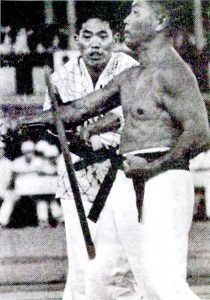
Sanchin test by Matayoshi Shinpô (background.)
Matayoshi Shinpô taught three versions of sanchin to Hayasaka shihan. That is to say, not only the sanchin of the Naha-te, but also that of the Shuri-te and that of the Tsuruken, each of which has its own characteristics.
“The sanchin I studied under the direction of Matayoshi sensei can be divided into three main systems. Shuri Sanchin, Naha Sanchin, and Tsuru Sanchin, each of them has its own characteristics, its own sequence and its own breathing ” explains Hayasaka shihan.
It is well known that sanchin is the basic form transmitted in Naha-te. However, sanchin is also transmitted in the karate currents that follow the Shuri-te lineage. Thus, the Motobu-ryû and schools of the Shuri-te lineage teach sanshin.
At the time of the kingdom of Ryûkyû, the members of the Mâ family, then Matayoshi, (sword nobility) were important characters, they transmitted their martial arts from generation to generation using kobudô as a first step. Always on the lookout for new techniques with or without weapons, they drew on the fighting arts passed down not only to Ryûkyû but also from those of the Chinese Ming and Qing dynasties and Japan. These three sanchin also reflect the refinement of the rich martial arts system of the Matayoshi family.
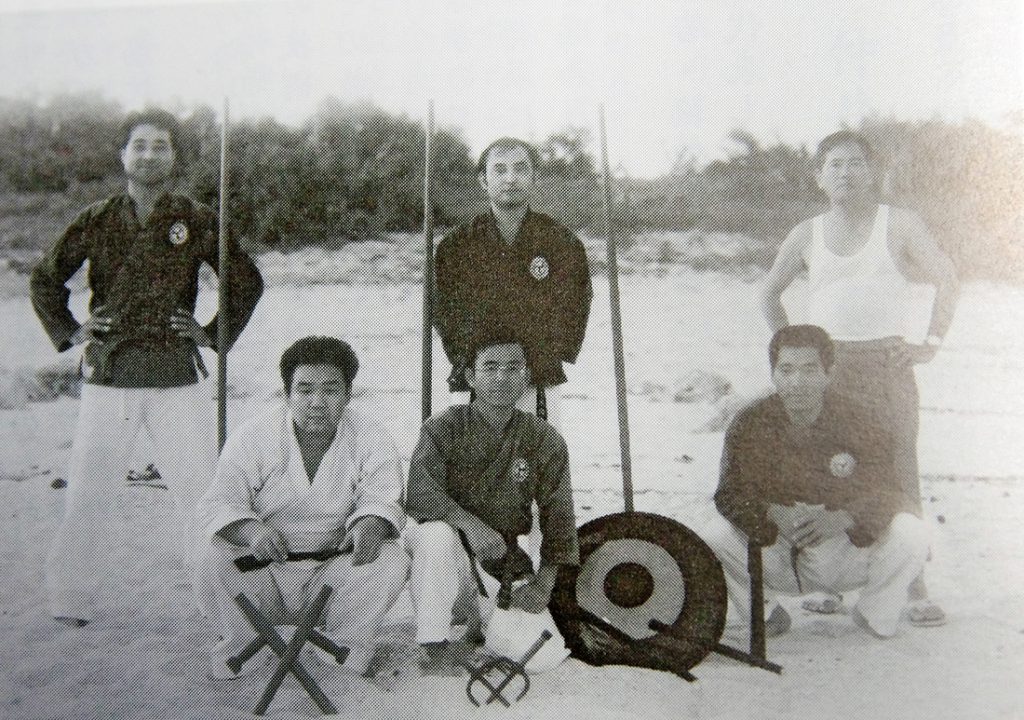
Photo of the early years of Kôdôkan. From left to right, squatting: Hayasaka Yoshifumi, Kamura Kôshin, Kamiya Seikô. Standing, from left to right: Yamashiro Ken’ichi, Gakiya Yoshiaki, Matayoshi Shinpô.
Hayasaka shihan went to Okinawa to study under Matayoshi Shinpô, from whom he finally obtained the menkyo-kaiden. He is actively engaged in transmitting Okinawan kingai-ryû karate and kobudô.
The legacy of the Matayoshi family: three sanchins
Hayasaka-shihan gives us a demonstration. Shurite sanchin is made with open hands, this is its characteristic. After the salute and the kanmon[2] , the left foot moves forward and takes a natural posture (shizentai-dachi), the hands open in supination, in front of the chest (kamae.). Pull the right hand up to the ribs, while breathing in through the nose. With abdominal breathing, extend the right arm in three steps, to the sound of “ha, ha, hass. “At the end of this extension, without making any noise, both hands reposition themselves in kamae, in front of the chest.
During the tsuki on the right and left, combined with the three-step breathing, the movements are done with parallel feet, without an arc of a circle.
[2] Kanmon is the most important movement of the style itself. It is the basic position adopted by virtue of the promise not to fight between disciples of the same school. The martial arts transmitted by Matayoshi shihan in Okinawa are based on the martial arts of Southern Shàolín, where salvation is paramount.
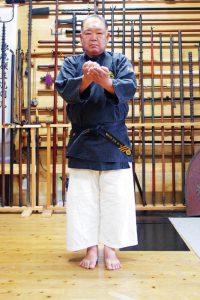
Shuri Sanchin salutation 1
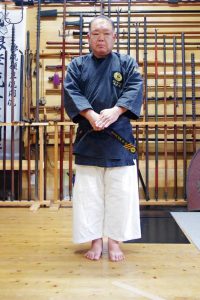
Shuri Sanchin salutation 2
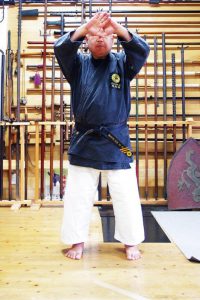
Shuri Sanchin 3 kanmon 1 The left foot moves apart, the two hands (the left one inside) join in front of the face, forming a triangle.
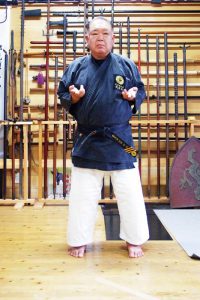
Shuri Sanchin 4 kanmon 2 In a semi-circle, pull the arms along the body, the hands are in supination, bent into a gutter shape…
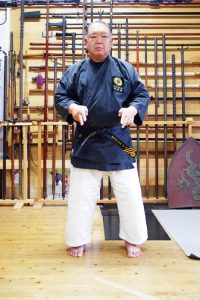
Shuri Sanchin 5 kanmon 3 The hands turn and descend, their forefingers and middle fingers pointing, ring and little fingers are bent towards the palms.
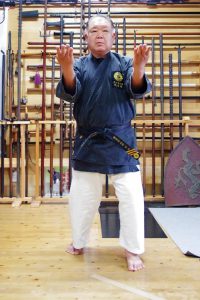 Shuri Sanchin 6 Shizentai 1 both elbows are bent in front of you, hands in supination (chûdan kamae), move the left leg forward, natural position (shizentai-dachi).
Shuri Sanchin 6 Shizentai 1 both elbows are bent in front of you, hands in supination (chûdan kamae), move the left leg forward, natural position (shizentai-dachi).
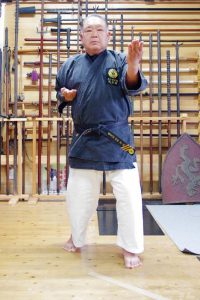
Shuri Sanchin 7 Pull your right hand under the armpit.
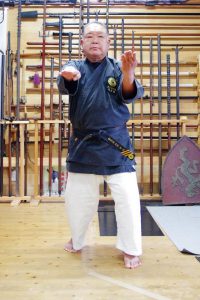
Shuri Sanchin 8 Stretch your right arm out to the rhythm of three exhalations.
In the Naha-sanchin, the left leg is spread out to come parallel, fists on the side of the thighs. From there, while advancing the left foot, in a semicircle, the right fist passes under the left elbow, and in a half-circle motion spread the right forearm from the inside outwards. The two arms, bent at the elbows, are positioned in front of the chest in a guard position (kamae.) Pull your left fist to the side, height of the sternum. At the rate of two-step “haa, haass” breathing, extend the arm and twist at the moment of impact. At this moment, the inclination of the arm must be the one said “mizunagare/water flow.” Turn your elbow to come back in kamae.
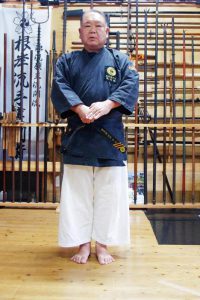
Naha Sanchin 1 salutation
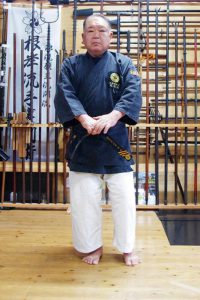
Naha Sanchin 2 kanmon 1
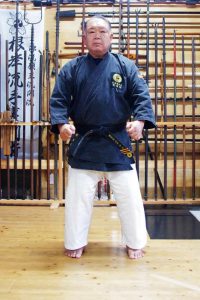
Naha Sanchin 3 kanmon 2 the leg spreads, the fists come in front of the thighs.
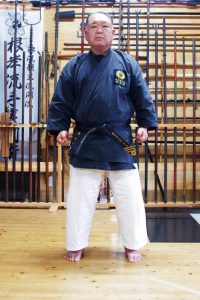
Naha Sanchin 4 kanmon 3 position your fists in tateken on the sides of the body.
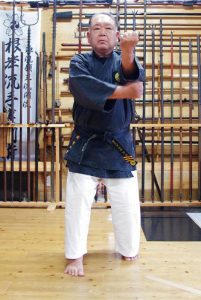
Naha Sanchin 5 advance your right foot while positioning your right fist under your left elbow.
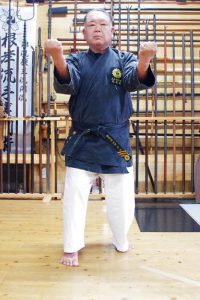
Naha Sanchin 6 spread your left fist
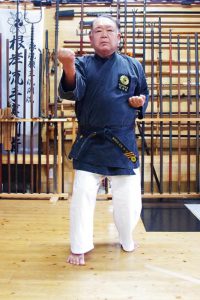 Naha Sanchin 7 pull your left fist under your under your armpit.
Naha Sanchin 7 pull your left fist under your under your armpit.
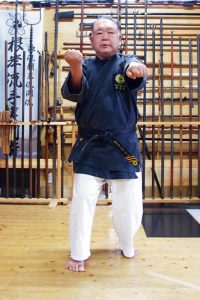
Naha Sanchin 8 at a two-stroke exhalation rate, extend your left arm.
The crane’s sanchin reflects the Chinese characteristic of the style. After the kanmon, move the right leg forward and position yourself in sanchin-dachi, palms of hands supination, then turn the wrists, fingertips to the ground, lower the hips and cross both palms in front of the navel, and throw gently your hands with a whipping motion. Exhale in one breath with a fah. This movement of a crane opening its wings is characteristic of the BaiheQuan of southern China.
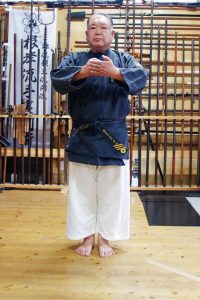
Tsuru Sanchin 1 salutation 1
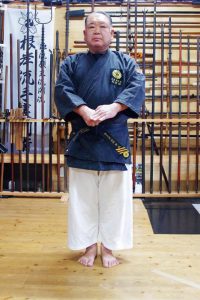
Tsuru Sanchin 2 salutation 2
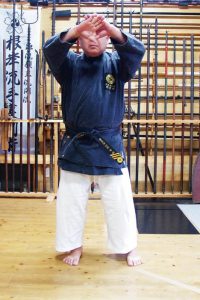
Tsuru Sanchin 3 kanmon. The left foot spreads, raise both hands to the level of your eyes, the right is inside. These two hands form an open triangle, the look filters through the gap…
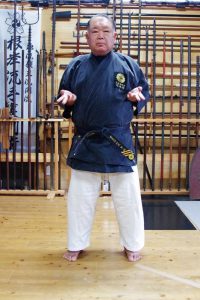
Tsuru Sanchin 4 … both arms describe an semicircle and come under your armpits…
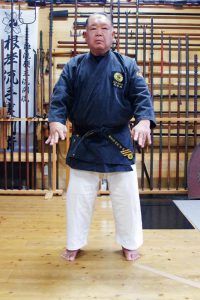 Tsuru Sanchin 5 … lower your hands, fingers spread…
Tsuru Sanchin 5 … lower your hands, fingers spread…
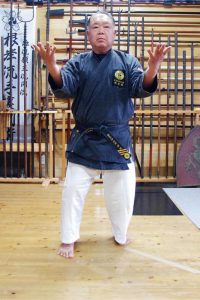 Tsuru Sanchin 6 … advance your right leg and position yourself in sanchin-dachi. Arms bent at the elbows, hands, fingers apart, end up in kamae, presenting “te no kô/carapace of hands” to the opponent …
Tsuru Sanchin 6 … advance your right leg and position yourself in sanchin-dachi. Arms bent at the elbows, hands, fingers apart, end up in kamae, presenting “te no kô/carapace of hands” to the opponent …
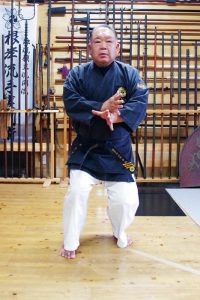
Tsuru Sanchin 7 … flex your legs, the two hands cross…
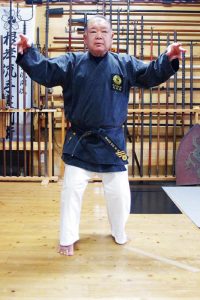 Tsuru Sanchin 8 … in a single exhalation, gently throw your hands in a whipping motion, and gently return your wrists in crane head/kakutô.
Tsuru Sanchin 8 … in a single exhalation, gently throw your hands in a whipping motion, and gently return your wrists in crane head/kakutô.
The essence of the techniques is hidden in the form
Each of the three sanchin has its own characteristics and bears the signature of Shurite, Nahate and Tsuruken. After having deepened each of the three sanchin, their principles can be transformed/adapted into real fighting principles through the knowledge of modified movements (Findi.) A song of Ryûkyû says ” Even if I show you karate, I don’t show the techniques. “The only things you can see are the talents of the performer, but his gestures do not reveal the principles. In other words, you should never show how to use your skills.
Classification of techniques in Okinawan karate :
Hente (Findi): optimal use of techniques integrated in the kata for real combat.
Urate (Uradi): provoke an action from the partner, anticipate your defence by dodging in order to have the best counter-attack angle.
Kakushite (Kakushidi):during kata performance, expressing the techniques that must be shown and hiding their true nature.
Okunote (Ukundi): to perform a kata, a technique, but in a completely different way, while letting you feel an expression of real efficiency.
Kinte (Fusedi): kata, techniques that should never be shown to the public.
Hayasaka Shihan showed us each of the three battles. This teaching is said to be transformed into a movement that can be used in practice.
After Hayasaka Shihan’s demonstration, he explained to us that through the principle of findi, their techniques can be applied to real combat.

Tsuru no te 1 : the thumb and earpiece are just tight enough to hold a ball. The other fingers just stretched out, without excessive force.
In tsuru-sanchin, the force is localised in the fingertips, all fingers are spread apart, it is “tsuru no te/crane hand . It is the same hand used to defeat your opponent when he holds your wrist, and you can use this hand pattern to parry an attack or to attack with kakutô, the crane head. Receive (uke) his attack with the back of your hand (kô no te) and grasp it by turning it outwards. Slide the attack with tsuru no te, open your hand and strike with kakutô. The opening and closing of the hands is similar to the opening and closing of the wings of a crane.
Pull down your palm, grasp the leg and throw your own leg towards its crotch. This movement is similar to the movement of the squeaky clean and shuffle.
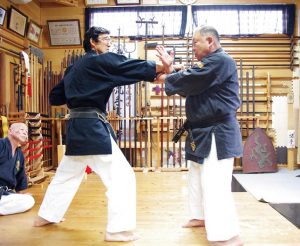 Tsuru Sanchin findi1 Hands crossed in front of your body, parry over your partner’s attack with “te no kô” …
Tsuru Sanchin findi1 Hands crossed in front of your body, parry over your partner’s attack with “te no kô” …
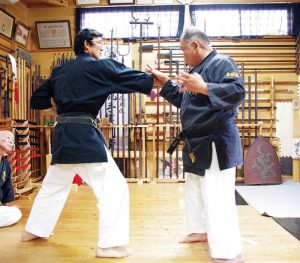
Tsuru Sanchin findi 2 … turn your right hand outwards to grab it…
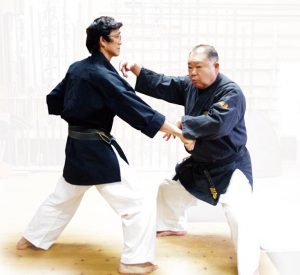 Tsuru Sanchin findi 3 … quickly, control the attack of your left hand and counter-attack by hitting the chin with kakutô.
Tsuru Sanchin findi 3 … quickly, control the attack of your left hand and counter-attack by hitting the chin with kakutô.
Kakuritsu-dachi, found in many kata of the kingaï-ryû: erected on one leg, the other is bent, ideally, the knee is against the belly, the arms, bent at the elbows, open. The toes of the raised leg are bent inwards, the foot raised, known as “tako-ashi/ octopus foot”, protecting the groin. This tako-ashi can also pick up sand or small gravel and throw it. A variation of this technique is to strike the scrotum with the toes flexed. This was one of Matayoshi sensei’s favorite techniques: “scooping” the opponent’s kick with “tsuru no te” and kicking the parts (without touching, of course.)
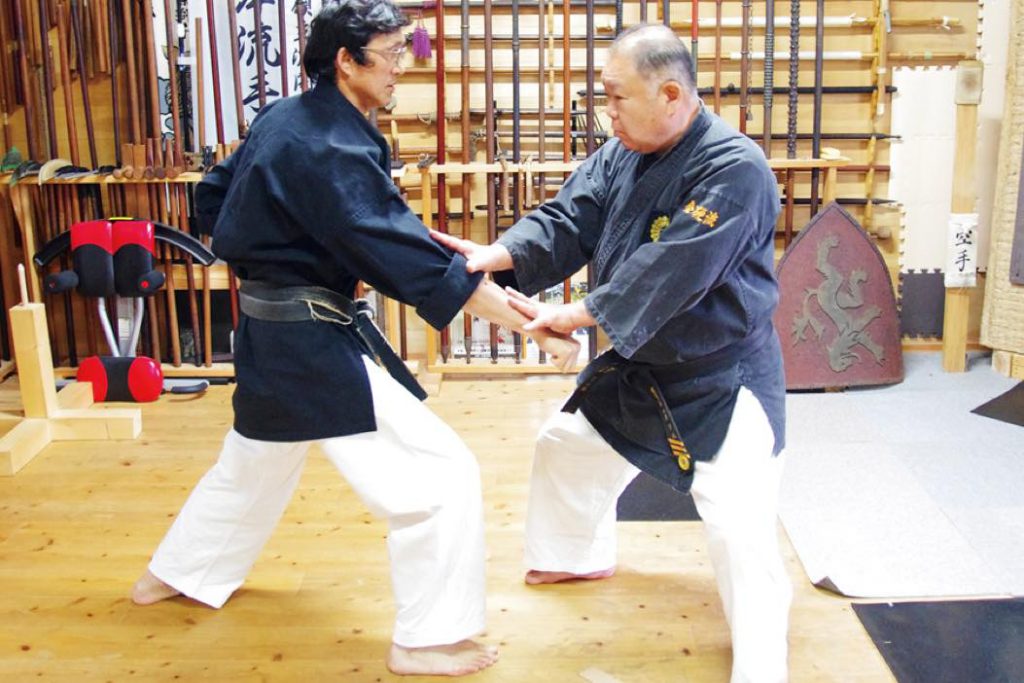
Tsuru no te 2 : receive the attack with tsuru no te.
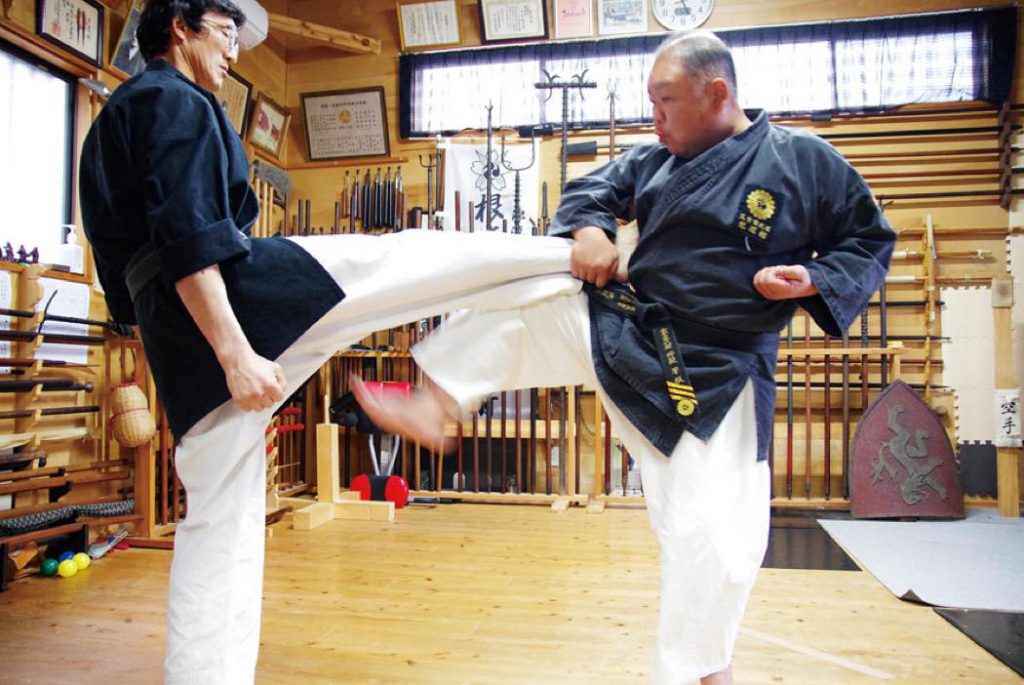 Tsuru no te 3 : against a kick, grab the ankle, deflect the attack and kick the scrotum.
Tsuru no te 3 : against a kick, grab the ankle, deflect the attack and kick the scrotum.
In the kata uhukûsankû of Kyan Chôtoku’s lineage, the technique where one is supposed to parry a two-handed attack is not just a simple parry. When you parry with your left hand, slide your right hand into the opponent’s neck.
But also pare with your left hand, “scoop” the leg and throw. After the parry, enter the attack (irimi) to throw the opponent off balance.
What is expressed as a simple block/parry technique can turn into a variety of attacking techniques as you learn to change the spirit of the technique.
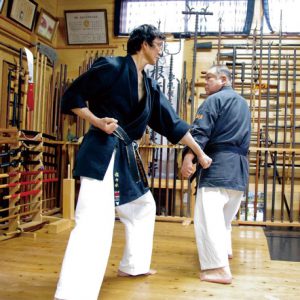
Kiyan Shôrin-ryû UhuKûsankû 1 While paring your left forearm the opponent’s left tsuki…
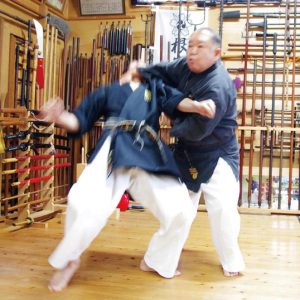 Kiyan Shôrin-ryû UhuKûsankû 2 … slide your right arm into its neck and project it.
Kiyan Shôrin-ryû UhuKûsankû 2 … slide your right arm into its neck and project it.
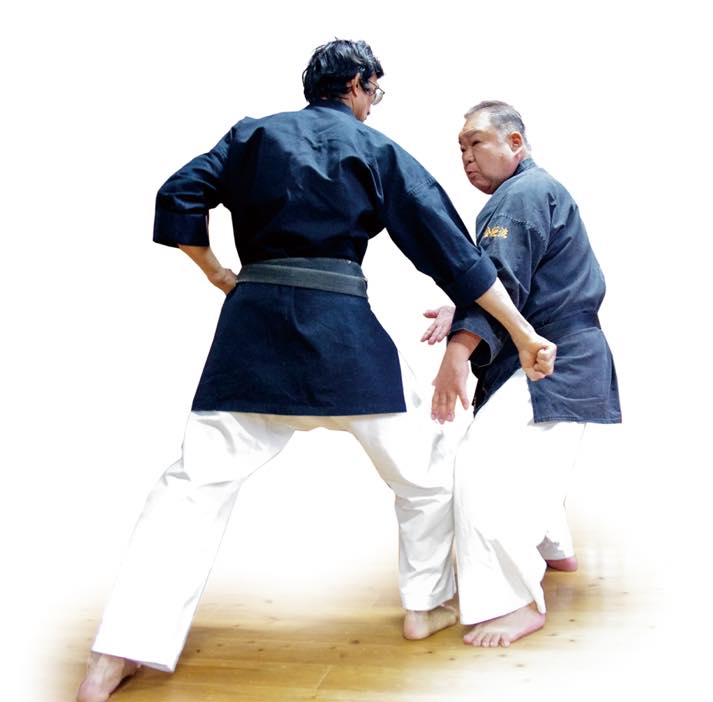
Kiyan Shôrin-ryû UhuKûsankû 3 Au moment où vous parez le tsuki droit de l’adversaire de votre avant-bras gauche, rentrez dans son attaque…
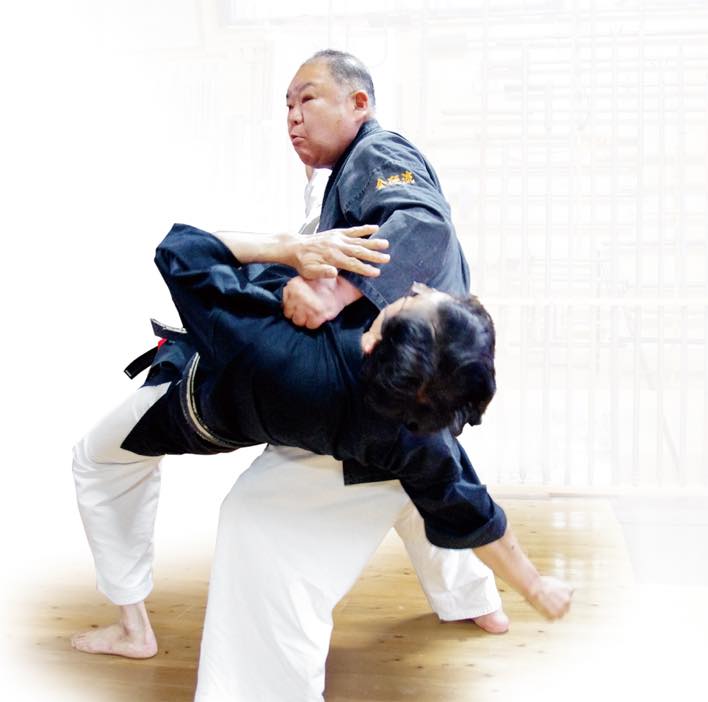 Kiyan Shôrin-ryû UhuKûsankû 4 … “scoope” his right leg and throw it.
Kiyan Shôrin-ryû UhuKûsankû 4 … “scoope” his right leg and throw it.
From there, by untwisting the forearm and without turning the elbow, the fist comes back in supination, in kamae. If you don’t understand this principle of small rotation and you make a large rotation of the arms, you will make a flashy technique that doesn’t involve hidden techniques.
In the opening of the Naha-sanchin, the opponent grabs your left wrist, your right fist passes under your left elbow. In continuity, in a fluid movement, while exhaling, exert pressure on the joint of his elbow. If you press forcefully, the elbow joint may be dislocated. As you exhale and exhale the force, the opponent is no longer able to control the elbow joint.
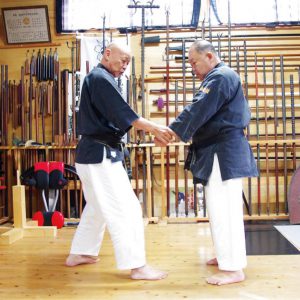
Naha Sanchin findi 1 : After the opponent has grasped your left wrist…
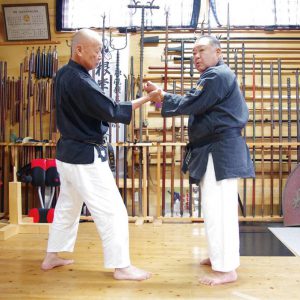
Naha Sanchin findi 2 … rotate your left forearm externally…
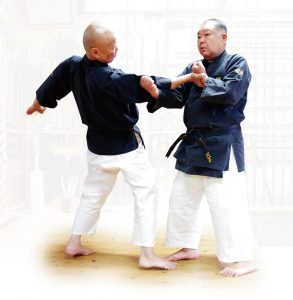
Naha Sanchin findi 3 … put your right forearm under his left elbow, while exhaling, press on the joint.
“Mizunagare/Water flow” of Naha-te and how to make in Shuri-te
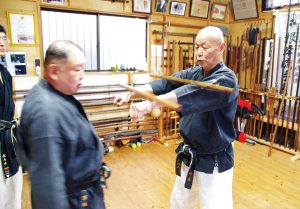
Naha-te’s mizunagare
One of the teachings of the Naha-sanchin: “mizunagare/flow of water. “When you stretch your arms out in front of you, they should be so inclined that a stick placed on them would roll slowly towards your wrists. The mizunagare tilt allows you to deflect by putting pressure on the forearm of the opponent who throws a punch. If the inclination is steeper or looser, your arm will not be able to properly slide the opponent’s arm or make close contact. The same is true for tsuki, mizunagare can aim at the xiphoid process of the sternum.
In Shurite, the rotation of the fist is more consequent. When the opponent grabs your arms, turn your palms inwards, inhale and exhale, raise the palms during the inhalation, and finally exhale and push both hands together letting your ki, internal energy, explode.
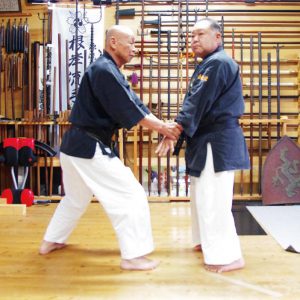
Shuri Sanchin hente 1 : When the opponent grabs both wrists…
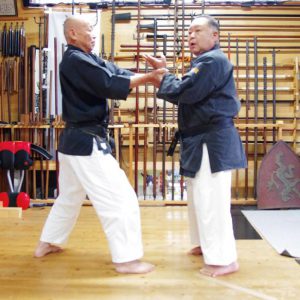
Shuri Sanchin hente 2 … Exhale by wrapping your palms inwards, and lift them by breathing…
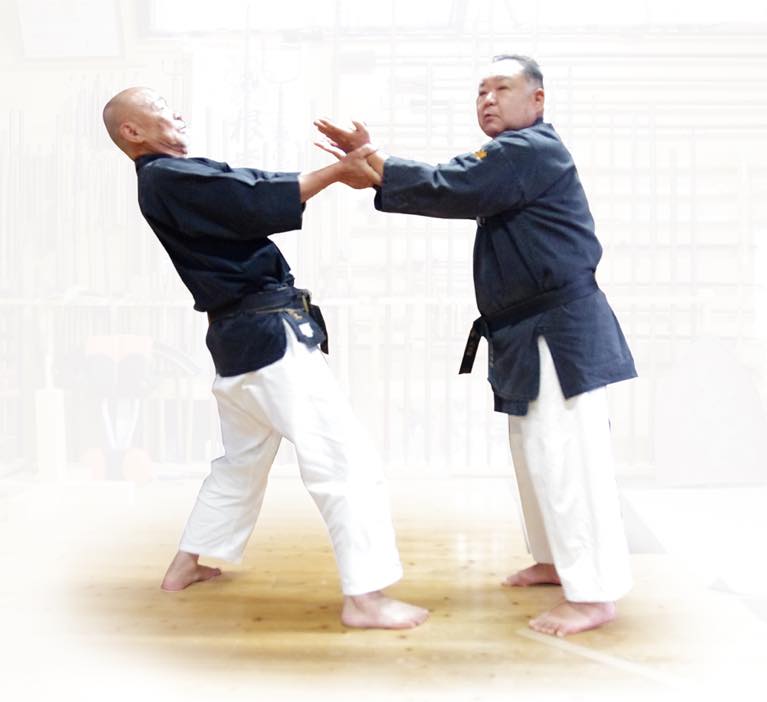
Shuri Sanchin hente 3 … extend your arms, hands in nukite and let your ki explode.
Against the opponent’s blows, parry by twisting your forearm, at the moment of contact, this twist will expel the attack and make an atifâ, (dry and rotating movement like that of a spinning top to repel the attack.) It is an extremely small movement, lively, with an instantaneous breathing which does not involve a great intervention of the hips. This is what happens in the third exhalation “haaass” in the Shuri-sanchin.

atifâ 1 : Hand or horizontal fist at the hip, supination, first exhalation…
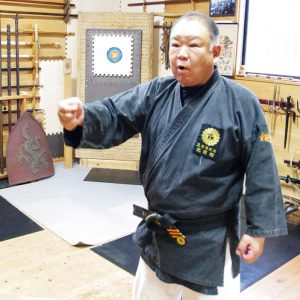
atifâ 2 : … vertical hand or fist, second exhalation…
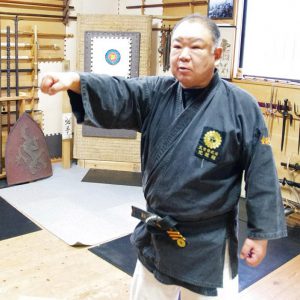
atifâ 3 … hand or horizontal fist in pronation, last exhalation.
To demonstrate the effect of the rotational force of the nukite, a disciple of Hayasaka shihan places his hand on the ground. Hayasaka shihan places the end of a stick on it. If the disciple tries to remove his hand by simply pulling it in a straight line, he has a hard time removing it. On the other hand, if he turns his palm inwards, he removes it without difficulty. This is called Shuri-te atifâ.
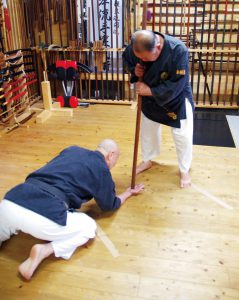
demonstration of nukite rotational strength
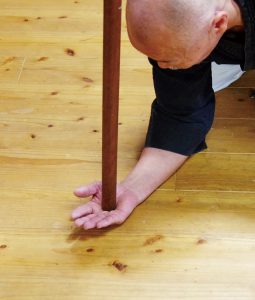
nukite rotation force 1
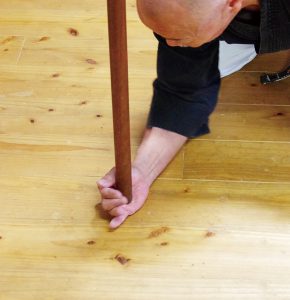
nukite rotation force 2

nukite rotation force 3
Each of the sanchin consists of simple movements, but if you practice them by concentrating on breathing and awareness of hand techniques (dexterity, skill…) they can be changed into real fighting techniques.
We, the interview team were able to see the essence of the sanchin, the foundations and inner workings of the Okinawan styles.

